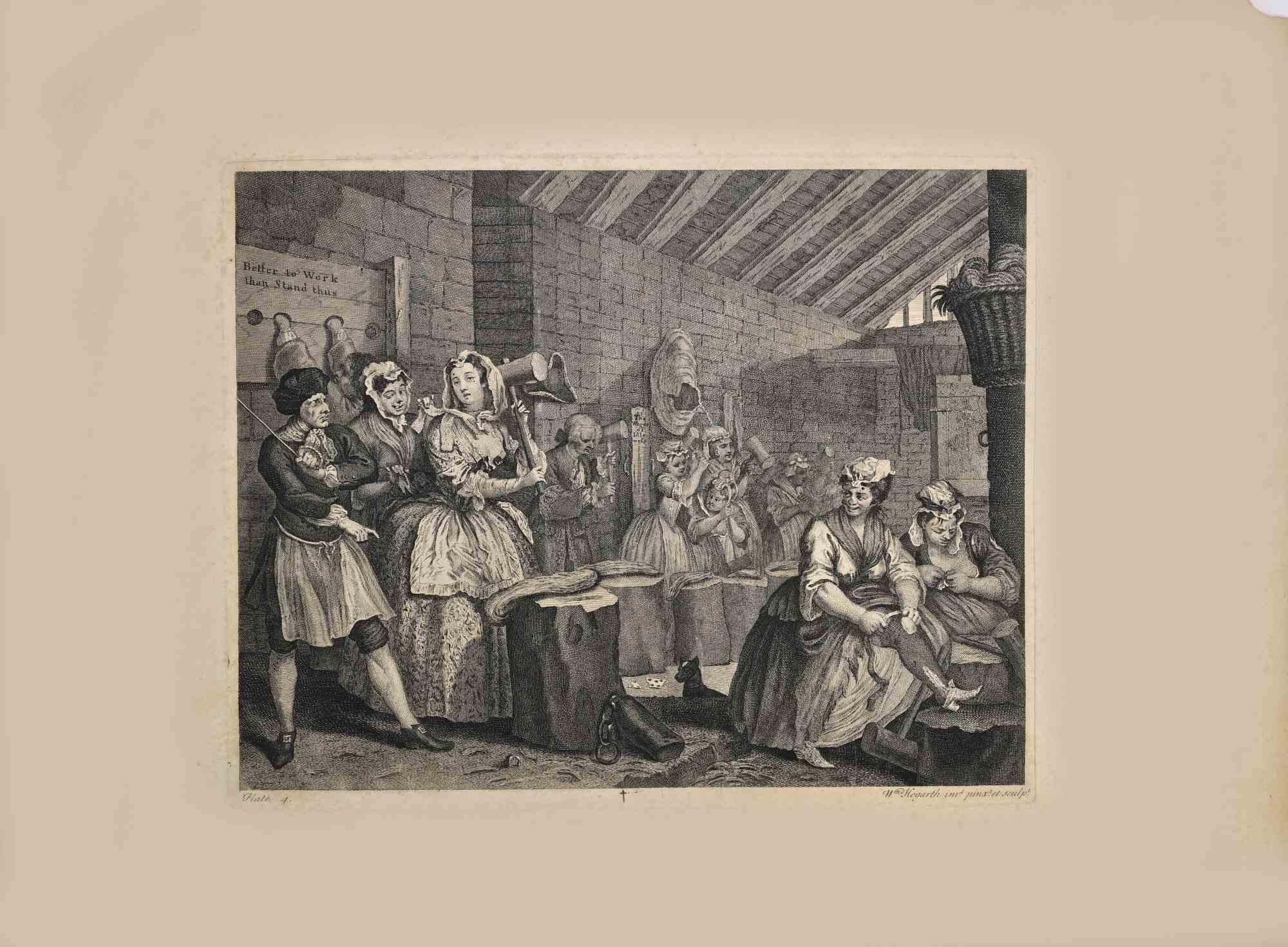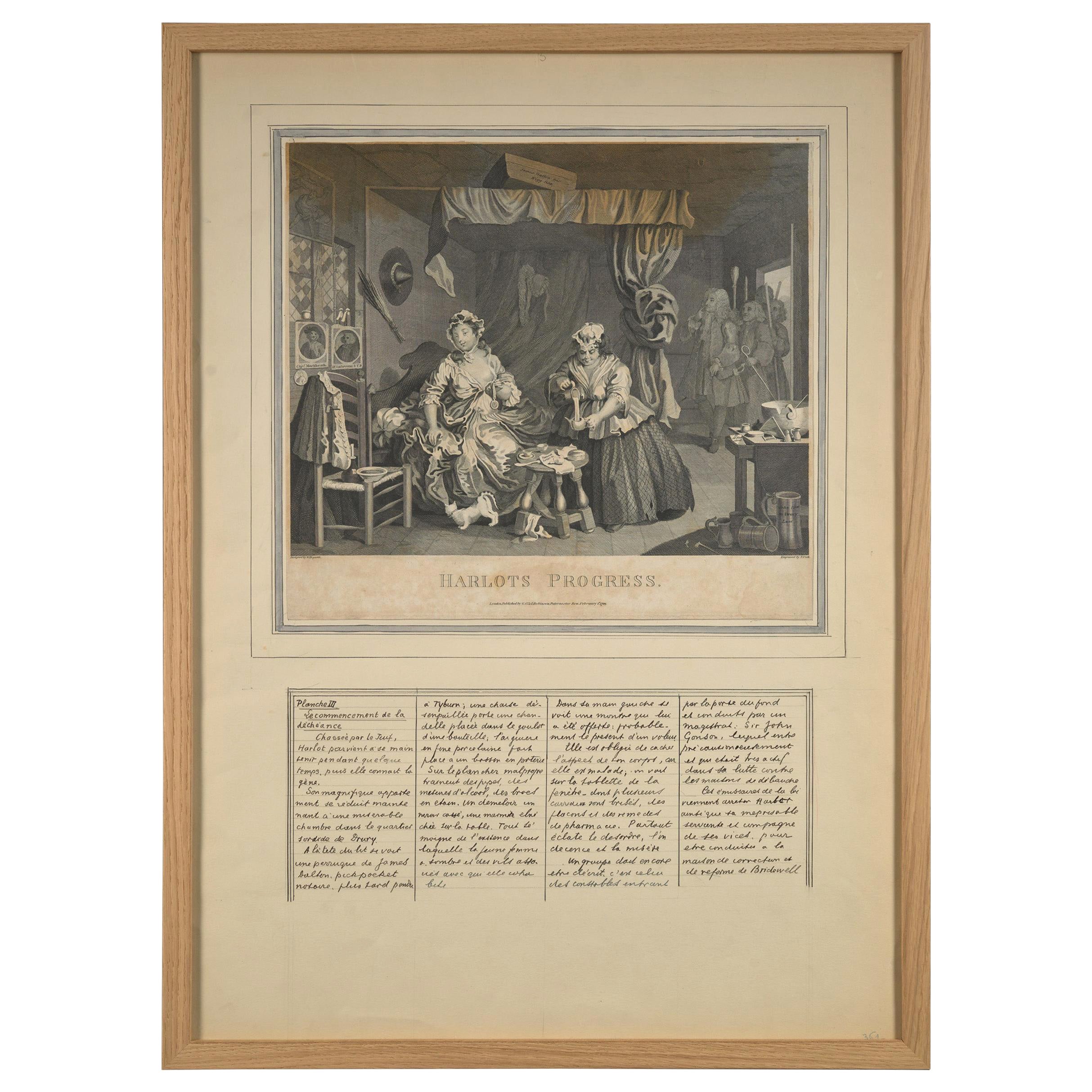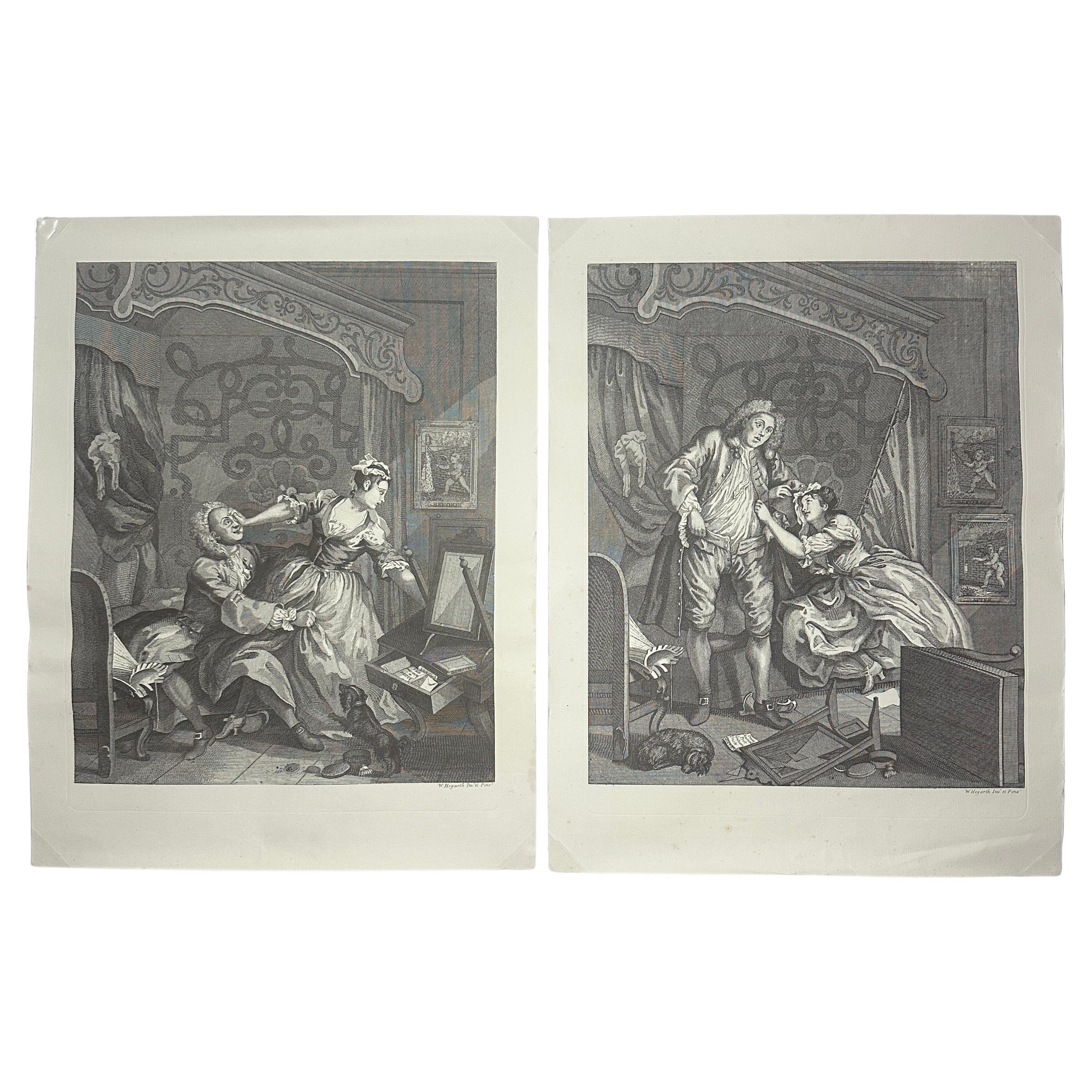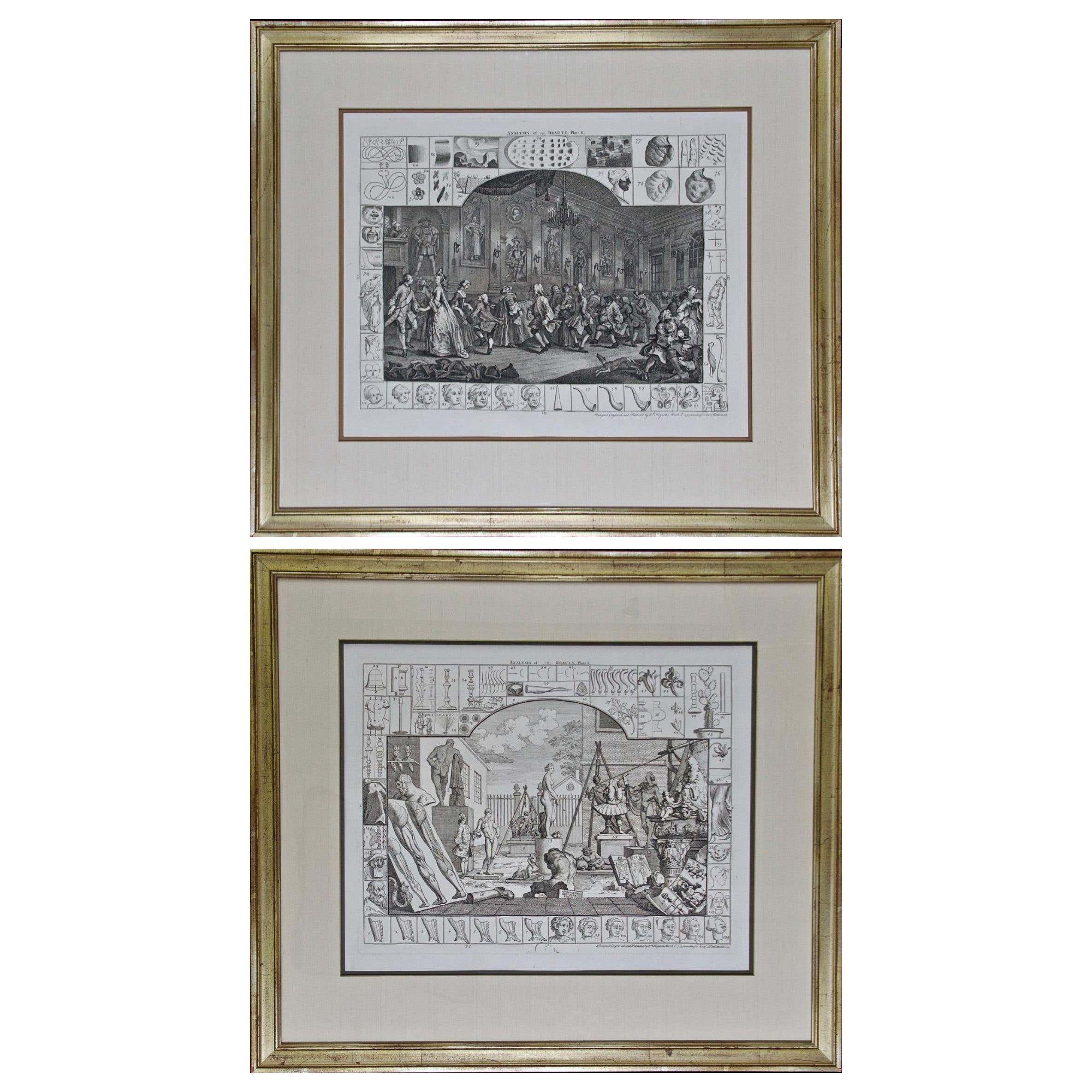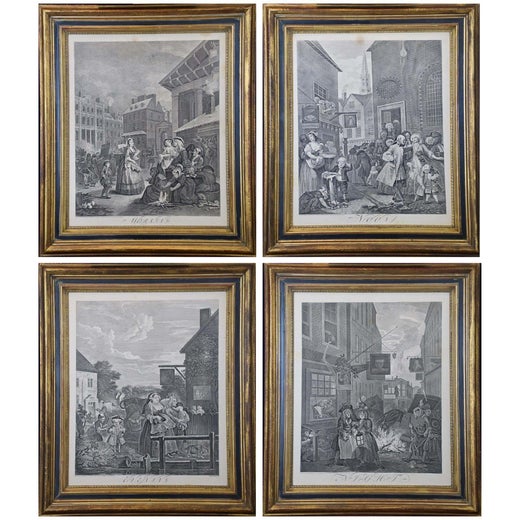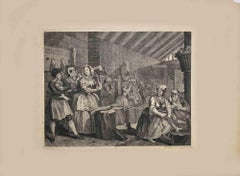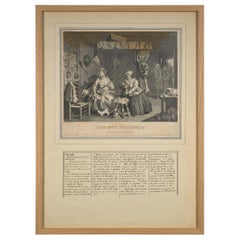Items Similar to "A Harlot's Progress" Plate 3 Etching
Want more images or videos?
Request additional images or videos from the seller
1 of 10
William Hogarth"A Harlot's Progress" Plate 3 EtchingFirst Created 1732
First Created 1732
$550
£415.40
€479.85
CA$774.87
A$829.89
CHF 446.14
MX$10,079.47
NOK 5,637.22
SEK 5,161.30
DKK 3,585.34
About the Item
Etching from the series titled "A Harlots Progress" by William Hogarth. The series consists of six paintings and engravings. The story is about a woman named M. Hackabout who arrived in London and started working as a prostitute. The third plate is of her getting arrest for her choice in profession. The series is a satirical story that emphasizes the dangers of being a prostitute and the health risks that come from it.
In 18th century engraving, the detail of the black mole on women and men's face is a symbol of the deadly venereal disease, syphilis. In this plate, Hackabout has already contracted the disease and that is why the black dot is visible on her forehead as well as her madam's.
In 1828, William Innell Clement published Harlot's Progress in columns on a single page of his newspaper Bell's Life in London #330. The detail with the cross seen in earlier reproductions of the engraving.
Dimensions without Frame: H 14.5 in x W 16.5 in.
Artist Biography: William Hogarth ( 10 November 1697 – 26 October 1764) was an English painter, printmaker, pictorial satirist, social critic, and editorial cartoonist. His work ranged from realistic portraiture to comic strip-like series of pictures called "modern moral subjects", perhaps best known to be his moral series A Harlot's Progress, A Rake's Progress and Marriage A-la-Mode. Knowledge of his work is so pervasive that satirical political illustrations in this style are often referred to as "Hogarthian".
Hogarth was born in London to a lower-middle-class family. In his youth, he took up an apprenticeship where he specialized in engraving. His father underwent periods of mixed fortune and was at one time imprisoned in lieu of outstanding debts; an event that is thought to have informed William's paintings and prints with a hard edge.
Influenced by French and Italian painting and engraving, Hogarth's works are mostly satirical caricatures, sometimes bawdily sexual, mostly of the first rank of realistic portraiture. They became widely popular and mass-produced via prints in his lifetime, and he was by far the most significant English artist of his generation. Charles Lamb deemed Hogarth's images to be books, filled with "the teeming, fruitful, suggestive meaning of words. Other pictures we look at; his pictures we read."
- Creator:William Hogarth (1697 - 1764, British)
- Creation Year:First Created 1732
- Dimensions:Height: 20 in (50.8 cm)Width: 23 in (58.42 cm)Depth: 1 in (2.54 cm)
- Medium:
- Movement & Style:
- Period:
- Condition:The frame is in Poor Condition but the print is in great condition.
- Gallery Location:Houston, TX
- Reference Number:Seller: A2019.0612.10561stDibs: LU55134779531
William Hogarth
William Hogarth (1697-1764) was an English painter, printmaker, pictorial satirist, social critic, and editorial cartoonist. Hogarth's work was extremely diverse, ranging from serious realistic paintings and portraits to satire and moralistic pieces filled with symbolism. He often communicated his moral message in a series of paintings and engravings, such as: A Rake's Progress, Marriage A-la-Mode and A Harlot's Progress. He was by far the most significant English artist of his generation and inspired a movement of English caricaturists and satirists, including James Gillray (1756-1815), Thomas Rowlandson (1757-1827), Isaac Cruickshank (1764-1811) and George Cruickshank (1792-1878). His work has been studied intensely for the greater than two and a half centuries since his death with several academic scholars focusing their careers on the analysis of every element of each of his creations.

About the Seller
5.0
Gold Seller
Premium sellers maintaining a 4.3+ rating and 24-hour response times
Established in 1969
1stDibs seller since 2014
888 sales on 1stDibs
Typical response time: 11 hours
- ShippingRetrieving quote...Shipping from: Houston, TX
- Return Policy
More From This Seller
View All"The Beggars Opera" and " A Just View of The British Stage" Original Etchings
By William Hogarth
Located in Houston, TX
The original design for the top half was formally attributed to William Hogarth, according to the Met Museum, and published by John Bowles in 1728. The edition here has a second half...
Category
1820s Baroque Figurative Prints
Materials
Etching
Portrait of an Elderly Woman Praying at a Table Etching
By William Harry Warren Bicknell
Located in Houston, TX
Portrait of a woman praying at a table with food. In the corner a cat reaching up to see over the table. The etching is signed by the artist in the botto...
Category
1910s Naturalistic Figurative Prints
Materials
Etching
"Under the Street Lamp" Imp. Etching
By Martin Lewis
Located in Houston, TX
Copperplate etching by Martin Lewis titled "Under the Street Lamp." Edition of 100. Printed on laid paper with watermark and 83 recorded impressions. McCarron catalogue raisonne #70. Signed in pencil with "imp" next to the signature. In the bottom right corner is a penciled 75 and in the top right corner is a 50. The etching is framed and was taken out of the frame for condition report and photographs. The gallery label is on the back of the matte inside the frame.
Dimensions without Frame: H 15 in x W 9.5 in.
Artist Biography: Martin Lewis (1881-1962) was born in Castlemaine, Victoria, Australia on 7 June 1881. He was the second of eight children and had a passion for drawing. At the age of 15, he left home and traveled in New South Wales, Australia, and in New Zealand, working as a pothole digger and a merchant seaman. He returned to Sydney and settled into a Bohemian community outside Sydney. Two of his drawings were published in the radical Sydney newspaper, The Bulletin. He studied with Julian Ashton at the Art Society's School in Sydney. Ashton, an English-born Australian artist and teacher, known for his support of the Heidelberg School and for his influential art school in Sydney. In 1900, Lewis left Australia for the United States. His first job was in San Francisco, painting stage decorations...
Category
1920s Naturalistic Figurative Prints
Materials
Etching, Laid Paper
Portrait Etching of English Victorian Poet Elizabeth Barrett Browning
By William Harry Warren Bicknell
Located in Houston, TX
Etching of a woman dressed in turn of the century attire looking out at the viewer. The work is signed in pencil by the artist. The etching is not framed.
Artist Biography: William...
Category
1910s Naturalistic Portrait Prints
Materials
Etching
“Truth is Stranger than Fiction” Black and White Abstract Etching Edition 4/15
By Margaret Smithers Crump
Located in Houston, TX
Black and white abstract etching by Houston artist Margaret Smithers-Crump. The work features a collection of abstracted sea creatures such as a crab, eel, and puffer fish. Signed, t...
Category
1980s Abstract Abstract Prints
Materials
Etching
"La Promanade" Black and White Print of a Women in a Carriage Edition
By Edgar Chahine
Located in Houston, TX
Black and white print of an upper class women in a carriage. There are other figures in the back riding in a carriage as well. Edition 17 of 58. Painting is signed by the artist and ...
Category
Early 1900s Expressionist Figurative Prints
Materials
Engraving
You May Also Like
A Harlot's Progress - Etching after William Hogarth - 1732
By William Hogarth
Located in Roma, IT
A Harlot's Progress is an etching print realized after William Hogarth in 1732
Signature on the plate on the lower right.
Good conditions, with some foxing.
A Harlot's Progress" i...
Category
1730s Surrealist Figurative Prints
Materials
Etching
William Hogarth, Harlot's Progress, Litographs with French Comments
Located in Leuven , BE
About the artist
William Hogarth (10 November 1697 – 26 October 1764) was an English painter, printmaker, pictorial satirist, social critic, and editorial cartoonist. His work ranges from realistic portraiture to comic strip-like series of pictures called "modern moral subjects", He is perhaps best known for his series A Harlot's Progress, A Rake's Progress and Marriage A-la-Mode. Knowledge of his work is so pervasive that satirical political illustrations...
Category
20th Century European Decorative Art
Materials
Paper
William Hogarth - 'Before and After' 2 Plate Etchings
By James Heath / William Hogarth
Located in Alpha, NJ
'Before and After' William Hogarth Etchings
Category
Antique 19th Century English Prints
Materials
Paper
William Hogarth . Original engravings 155 pсs., 1 piece with blend. 1822 London
By William Hogarth
Located in Riga, LV
William Hogarth (1697-1764)
Original engravings 155 pсs., 1 piece with blend. 1822 London
From A. Neibergs collection
Category
1820s Realist Figurative Prints
Materials
Paper, Engraving
William Hogarth's "Analysis of Beauty": A Set of Two Framed 18th C. Engravings
By William Hogarth
Located in Alamo, CA
The two plates in this set were created utilizing both engraving and etching techniques by William Hogarth in 1753, originally as illustrations of his book on aesthetics, entitled "Analysis of Beauty". Due to their popularity, these plates were later published separately. The publication line in the lower right reads: "Designed, Engraved, and Publish'd by Wm. Hogarth, March 5th 1753, according to Act of Parliament." Hogarth's original copper plates were refurbished where needed by James Heath and engravings were republished in London in 1822 by Braddock, Cradock & Joy. This was the last time Hogarth's copper plates were used for printing. Most were melted during World War I for the construction of bombs.
These large folio sized "Analysis of Beauty" engravings are presented in antiqued gold-colored frames with double mats; the outer silk mats are light brown-colored and the inner mats are dark brown. Each frame measures 27.38" x 31.25" x 1.13". There is one tiny spot in the right margin of plate 1 and another in the lower margin; the latter could be from the printing process. The prints are otherwise in excellent condition.
The "Analysis of Beauty" series is in the collection of many major museums, including: The British Museum, The Metropolitan Museum of Art, The Tate Museum, The Chicago Art Institute and The Fine Arts Museums of San Francisco.
The first engraving (Plate 1) depicts a courtyard of statues which is filled with some of the most famous works of classical sculpture. The most important sculptures are surrounded by less impressive works. The Medicean Venus (#13) is in the center with a statue of Julius Caesar (#19) to the right, elevated on a pulley with a short, overdressed Brutus stands over the falling Caesar. The Apollo Belvedere (#12) is next. A judge stands to the right with his foot on a cherub (#16). Another crying cherub holds a gallows and wipes his tears with the judge's robe.
A sphinx (#21) and the drunken Silenus (#107) are below the Venus. Michaelangelo's torso (#54) and a statue of Antonius (#6) are seen in the foreground. The Farnese Hercules (#3) and a bust of another Hercules (#4) under two statuettes of Isis are also included in the scene.
The key to these objects is included in the form of a serpentine line winding around a cone (#26), Hogarth's "Line of Beauty". For Hogarth the winding line is an essential element of beauty in art. Hogarth's theory of beauty is communicated in this plate.
Plate 2 is thought to represent the Wanstead Assembly, with the Earl of Tynley and his household. It is an adaptation of a scene in the Happy Marriage series, which complements Hogarth's Marriage à la Mode...
Category
Mid-18th Century Old Masters Interior Prints
Materials
Engraving, Etching
Four Framed Hogarth Engravings "Four Times of the Day"
By William Hogarth
Located in Alamo, CA
The four plates in this "Four Times of the Day" set were created utilizing both engraving and etching techniques by William Hogarth in 1738. Hogarth's original copper plates were refurbished where needed by James Heath and these engravings were republished in London in 1822 by Braddock, Cradock & Joy. This was the last time Hogarth's original copper plates were used for printing. Most were melted down during World War I for the construction of bombs. Printed upon early nineteenth century wove paper and with large, full margins as published by William Heath in 1822. The inscription below each print reads "Invented Painted & Engraved by Wm. Hogarth & Publish'd March 25. 1738 according to Act of Parliament".
These large folio sized "Four Times of the Day" engravings/etchings are presented in complex gold-colored wood frames with black bands and scalloped gold inner trim. A majority of each thick impressive frame is covered with glass applied near the outer edge. Each frame measures 25.75" high, 22.25" wide and 1.88" deep. There are a few small dents in the edge of these frames, which are otherwise in very good condition. "Morning" has two focal areas of discoloration in the upper margin and some discoloration in the right margin, a short tear in the left margin and a short tear or crease in the right margin. "Noon" has a spot in the upper margin that extends into the upper image, but it is otherwise in very good condition. "Evening" has a faint spot in the upper margin, but it is otherwise in very good condition. "Night" is in excellent condition.
The "Four Times of the Day" series is in the collection of many major museums, including: The British Museum, The Metropolitan Museum of Art, The Tate Museum, The Chicago Art Institute and The Victoria and Albert Museum.
Through this series Hogarth is portraying early 18th century London street life at "Four Times of the Day". His characters are exhibiting their personalities, quircks, strange activities, but he also wants to draw attention the disparities between the wealthy aristocracy and the common working class.
Plate 1, "Morning" depicts morning in Covent Garden in the winter in front of Tom King...
Category
Mid-18th Century Old Masters Landscape Prints
Materials
Engraving, Etching
